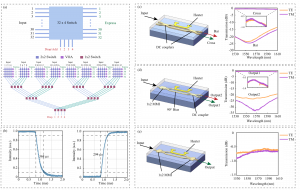
USA, May 10, 2024 /EINPresswire.com/ — Reconfigurable optical add-drop multiplexers (ROADM) are critical components in flexible optical networks for the dynamic channel reassignment. A university and industrial collaborative effort in China has led to the development of a compact, integrated optical switch matrix for the ROADM applications that is both low-loss and polarization-independent. Besides optical networks, the newly developed switch matrix platform will open new possibilities in other applications such as quantum processing and photonic neural networks.
The implementation of integrated optical switches shows promises in the size reduction of ROADMs for greater flexibility and compactness, ultimately leading to robust single-chip solutions. Despite decades of research on switches with various structures and platforms, achieving a balance between dense integration, low insertion loss (IL), and polarization-dependent loss (PDL) remains a significant challenge.
In a new paper (https://doi.org/10.1038/s41377-024-01456-8) published in Light Science & Applications, a team led by Professor Sai Tak Chu from Department of Physics, City University of Hong Kong, Hong Kong, China, and Dr. Brent E. Little of QXP Technologies Inc., Xi’an, China, along with their collaborators, have demonstrated a low-loss and polarization-independent integrated optical colorless ROADM. The 32 ´ 4 optical switch is designed to route any of the 32 inputs to the express ports or drop any channels from 32 inputs to the target 4 drop ports or add any of the 4 ports to any of the 32 express channels.
At 1550 nm, the fiber-to-fiber loss for each express channel is below 2 dB and across the C and L bands, below 3 dB. For each input channel to all 4 drop/add channels at 1550 nm, the loss is less than 3.5 dB and less than 5 dB across the C and L bands. The PDLs for all express and input channels to the 4 drop/add channels are below 0.3 dB over the C band, and the crosstalk is under -50 dB for both the C and L bands.
The ROADM is based on the high-index doped silica glass (HDSG) platform of QXP Technologies Inc., featuring an adjustable waveguide index-contrast of 10% to 20%, which is lower than the Si and SiN waveguides but higher than the low index contrast silica waveguides. It strikes a balance between fiber coupling loss, propagation loss and PDL, while maintaining high integration density. With the assistance of monolithically integrated spot-size converters, the coupling loss from standard single-mode-fiber (SMF) with mode field diameter of 10.4 mm into waveguides with 2 mm by 2 mm mode fields is lower than 0.4 dB/facet, and PDL is below 0.07 dB across the C and L bands. These attributes of low loss and low PDL make the platform promising for the integration of switch devices.
The switch comprises 188 MZI-type switch elements. The measured fiber-to-fiber losses on express and drop channels of the fully optical and electronic packaged device are within 3 dB and below 5 dB for 32 channels, respectively, within C and L bands. The PDL of the device is below 0.3 dB in the C band. Thirty-two variable optical attenuators (VOAs) are also incorporated, and the PDL is lower than 1 dB within the C band at 10 dB VOA attenuation.
The researchers summarized the design principle of their ROADM:
“The switch matrix also consists of a total of 618 waveguide-waveguide crossings that can contribute to both the IL and crosstalk. To limit the amount of loss and crosstalk introduced by the crossings, the waveguides are distributed across two vertical layers to allow the waveguides to cross over each other. Using this approach, we are able to reduce the crosstalk to less than -50 dB for the express for the express channels and -40 dB for the add/drop channels.”
They added:
“To accommodate the three-dimensional design, the design also includes an additional 88 optical vias and 44 optical bridges to connect the waveguides between the layers.”
and forecasted:
“Optical switch is a fundamental element of optical circuit. The presented low-loss and polarization-independent switch can benefit the development of programmable photonic integrated circuits in applications such as optical neural networks and integrated quantum photonics”.
DOI
10.1038/s41377-024-01456-8
Original Source URL
https://doi.org/10.1038/s41377-024-01456-8
Funding information
This work was supported by City University of Hong Kong under Grant No. APRC 9610395 and the Fundamental Research Funds for the Central Universities under Grant No. 2023RC50.
Lucy Wang
BioDesign Research
email us here
![]()
Originally published at https://www.einpresswire.com/article/710513101/low-loss-and-polarization-insensitive-32-x-4-optical-switch-for-roadm-applications





